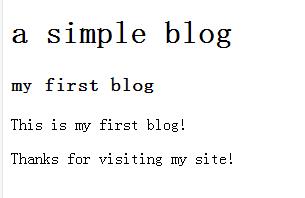这一节我们来了解模板和视图、URL的使用。
一.使用模板
在blog目录中新建templates文件夹,在templates文件夹下新建base.html文件。目录结构如下

templates/
base.html
编写base.html文件

<!DOCTYPE html> <html lang="en"> <head> <meta charset="UTF-8"> <title> {% block title %} {% endblock %} </title> </head> <body> <h1>a simple blog</h1> {% block content %} {% endblock %} {% block footer %} <p>Thanks for visiting my site!</p> {% endblock %} </body> </html>
base.html定义了一个简单的html框架,接下来将在所有的页面中使用。
在templates目录下新建blog_list.html

{% extends "base.html" %} {% block title %} blog list {% endblock %} {% block content %} <div class="content"> {% for blog in blogs %} <h3>{{ blog.caption }}</h3> <div>{{ blog.content}} </div> {% endfor %} </div> {% endblock %}
二.配置视图文件
在blog目录中编辑views.py

from django.shortcuts import render_to_response from blog.models import Blog def blog_list(request): blogs = Blog.objects.all() return render_to_response("blog_list.html", {"blogs": blogs})
三.配置url
在web目录中编辑urls.py

urlpatterns = patterns('', # Examples: # url(r'^$', 'web.views.home', name='home'), # url(r'^blog/', include('blog.urls')), url(r'^admin/', include(admin.site.urls)), url(r'^web/',include('blog.urls')), )
在blog目录中添加urls.py 文件

from django.conf.urls import * urlpatterns = patterns(('blog.views'), url(r'^bloglist/$', 'blog_list', name='bloglist'), )
使用admin添加几个tag、blog、和author,最后运行服务器,打开127.0.0.1:8000/web/bloglist,显示如下界面

四、添加博客展示页面
在templates目录中添加blog_show.html。

{% extends "base.html" %} {% block title %} {{ blog.caption }} {% endblock %} {% block content %} <div class="content"> <h2>blog show</h2> <h4>{{ blog.caption }}</h4> <div>{{ blog.content }} </div> </div> {% endblock %}
在views.py文件中添加blog_show视图函数

from django.http import Http404
def blog_show(request, id=''):
try:
blog = Blog.objects.get(id=id)
except Blog.DoesNotExist:
raise Http404
return render_to_response("blog_show.html", {"blog": blog})
修改blog目录下面的urls.py ,添加如下内容
url(r'^blog/(?P<id>d+)/$','blog_show',name='detailblog'),
修改blog_list.html
<h3>{{ blog.caption }}</h3>
将其改为
<h3> <a href="{% url 'detailblog' blog.id %}"> {{ blog.caption }} </a> </h3>
特别注意的是detailblog一定要带上单引号,再次刷新下blog_list页面,博客标题就便成了链接。
